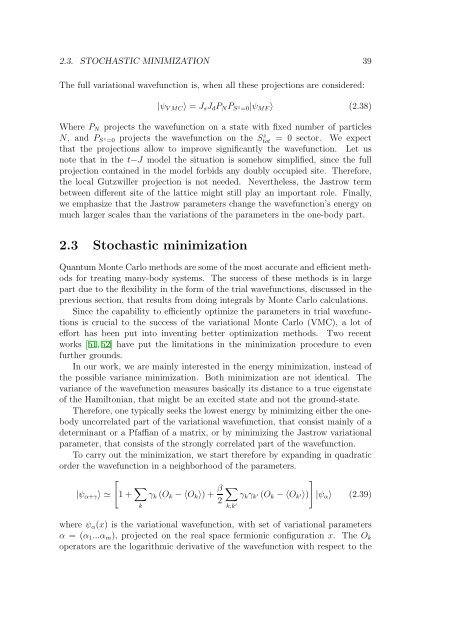pdf, 9 MiB - Infoscience - EPFL
pdf, 9 MiB - Infoscience - EPFL
pdf, 9 MiB - Infoscience - EPFL
You also want an ePaper? Increase the reach of your titles
YUMPU automatically turns print PDFs into web optimized ePapers that Google loves.
2.3. STOCHASTIC MINIMIZATION 39<br />
The full variational wavefunction is, when all these projections are considered:<br />
|ψ VMC 〉 = J s J d P N P S z =0|ψ MF 〉 (2.38)<br />
Where P N projects the wavefunction on a state with fixed number of particles<br />
N, and P S z =0 projects the wavefunction on the Stot z = 0 sector. We expect<br />
that the projections allow to improve significantly the wavefunction. Let us<br />
note that in the t−J model the situation is somehow simplified, since the full<br />
projection contained in the model forbids any doubly occupied site. Therefore,<br />
the local Gutzwiller projection is not needed. Nevertheless, the Jastrow term<br />
between different site of the lattice might still play an important role. Finally,<br />
we emphasize that the Jastrow parameters change the wavefunction’s energy on<br />
much larger scales than the variations of the parameters in the one-body part.<br />
2.3 Stochastic minimization<br />
Quantum Monte Carlo methods are some of the most accurate and efficient methods<br />
for treating many-body systems. The success of these methods is in large<br />
part due to the flexibility in the form of the trial wavefunctions, discussed in the<br />
previous section, that results from doing integrals by Monte Carlo calculations.<br />
Since the capability to efficiently optimize the parameters in trial wavefunctions<br />
is crucial to the success of the variational Monte Carlo (VMC), a lot of<br />
effort has been put into inventing better optimization methods. Two recent<br />
works [51, 52] have put the limitations in the minimization procedure to even<br />
further grounds.<br />
In our work, we are mainly interested in the energy minimization, instead of<br />
the possible variance minimization. Both minimization are not identical. The<br />
variance of the wavefunction measures basically its distance to a true eigenstate<br />
of the Hamiltonian, that might be an excited state and not the ground-state.<br />
Therefore, one typically seeks the lowest energy by minimizing either the onebody<br />
uncorrelated part of the variational wavefunction, that consist mainly of a<br />
determinant or a Pfaffian of a matrix, or by minimizing the Jastrow variational<br />
parameter, that consists of the strongly correlated part of the wavefunction.<br />
To carry out the minimization, we start therefore by expanding in quadratic<br />
order the wavefunction in a neighborhood of the parameters.<br />
[<br />
|ψ α+γ 〉≃ 1+ ∑ ]<br />
γ k (O k −〈O k 〉)+ β ∑<br />
γ k γ k ′ (O k −〈O k ′〉) |ψ α 〉 (2.39)<br />
2<br />
k<br />
k,k ′<br />
where ψ α (x) is the variational wavefunction, with set of variational parameters<br />
α =(α 1 ...α m ), projected on the real space fermionic configuration x. The O k<br />
operators are the logarithmic derivative of the wavefunction with respect to the
















